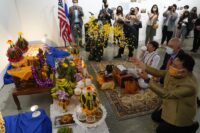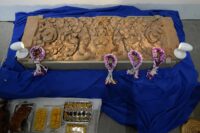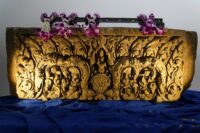 Two hand-carved lintels have been returned to Thailand 50 years after they were stolen from ancient temples and smuggled out of the country. They were officially handed over to officials from the Royal Thai Consulate in a ceremony that included traditional Thai dancers and prayers at Los Angeles on Tuesday.
Two hand-carved lintels have been returned to Thailand 50 years after they were stolen from ancient temples and smuggled out of the country. They were officially handed over to officials from the Royal Thai Consulate in a ceremony that included traditional Thai dancers and prayers at Los Angeles on Tuesday.
The 1,500-pound sandstone lintels were carved in the pre-Angkorean Baphuon style in the 9th-10th century when Thailand was part of the Khmer Empire. They were stolen from the Nong Hong Temple and the Khao Lon Temple in northeastern Thailand in the 1960s. The last time the Nong Hong lintel was documented in its original location was 1959. The Khao Lon lintel was in place until at least 1967. Avery Brundage, then President of the International Olympic Committee and an insatiable collector of Asian art, bought the former from a London auction house in 1966 and the latter from a gallery in Paris in 1968.
 Brundage donated some of his enormous collection to the city of San Francisco and the Asian Art Museum was built to house it in 1966. He bequeathed the rest of his collection to his museum after his death in 1975. Today the museum has 7,700 Brundage pieces in its 17,000 piece collection. The problem is Brundage, a notorious anti-Semite and racist, gave not a single rat’s ass about the ownership histories of any of the loot in his collection, so now the museum is paying the price for Brundage’s cavalier covetousness.
Brundage donated some of his enormous collection to the city of San Francisco and the Asian Art Museum was built to house it in 1966. He bequeathed the rest of his collection to his museum after his death in 1975. Today the museum has 7,700 Brundage pieces in its 17,000 piece collection. The problem is Brundage, a notorious anti-Semite and racist, gave not a single rat’s ass about the ownership histories of any of the loot in his collection, so now the museum is paying the price for Brundage’s cavalier covetousness.
The worm turned on the lintels in 2016. A picture of one of the lintels caught the eye of a Thai non-profit cultural heritage organization and in September of that year, Consul General of the Royal Thai Consulate in Los Angeles visited in person. He told museum curators that the lintels had been stolen and Thailand wanted them back. The museum ghosted him and other Thai officials until the Department of Justice opened an investigation in 2017.
 After a long and thorough investigation, the US Attorney’s filed an asset forfeiture complaint against the City of San Francisco in October, 2020. It detailed the evidence that the lintels had been stolen, including correspondence between Brundage and both the London and Paris galleries concerning archaeological evidence that the lintels had been looted and appeals from Thai officials for their return.
After a long and thorough investigation, the US Attorney’s filed an asset forfeiture complaint against the City of San Francisco in October, 2020. It detailed the evidence that the lintels had been stolen, including correspondence between Brundage and both the London and Paris galleries concerning archaeological evidence that the lintels had been looted and appeals from Thai officials for their return.
The museum’s argument was that there was no explicit proof that the lintels were stolen, but temples do not willingly sell pieces of themselves, especially structural features carved with scenes of religious import, and Thai laws going back to 1935 prohibit the export of protected cultural artifacts except under extremely limited circumstances which require a license. They also claim the letters between Brundage and his loot suppliers were talking about a third piece which Brundage returned to Thailand in 1970. Those dogs didn’t hunt, as the saying goes, and in February 2021 the parties settled the case with the museum agreeing to consent to the forfeiture.
The lintels are scheduled to arrive in Thailand on Friday. After an initial examination by experts from the Thai Fine Arts Department, the carved stones will go on display at the Bangkok National Museum for three months.